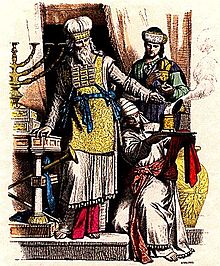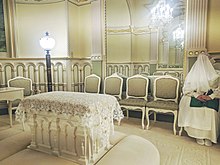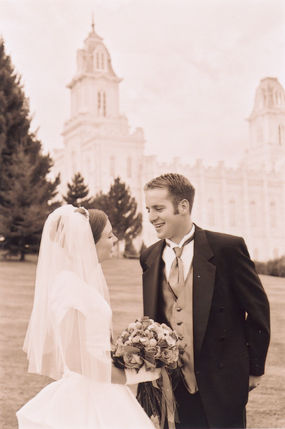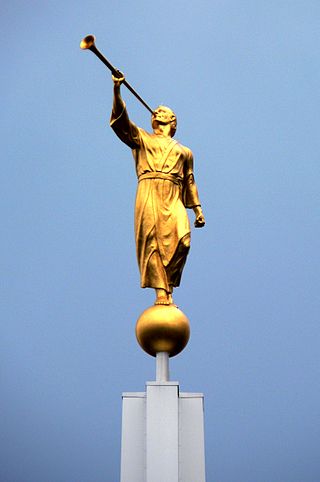This article needs additional citations for verification .(June 2011) |

Temple robes describe the ceremonial clothing worn in the performance of ordinances and ceremonies in a temple.
This article needs additional citations for verification .(June 2011) |

Temple robes describe the ceremonial clothing worn in the performance of ordinances and ceremonies in a temple.
Traditional robes, worn by monks both within and without Buddhist temples, appear in a variety of configurations. In parts of Southeast Asia, the robes consist of a saffron-colored mantel over a red undergarment. In Japan, the robe is traditionally black, grey or blue.
The 28th and 29th chapters of the Book of Exodus describe in detail the ritual clothing worn by priests in the Temple. The robes consist of a breastplate ( hoshen ), an ephod , a robe ( me'il ), a tunic ( ketonet ), a cap ( mitznefet ), and a sash ( avnet ), as well as stones worn in various configurations.

Members of the Church of Jesus Christ of Latter-day Saints (LDS Church) and certain Mormon fundamentalists wear ceremonial robes to perform the endowment and sealing portions of their temple ceremonies. The ceremonial robes are modeled after those described in the Bible according to latter-day revelation. The clothing includes a robe that fits over one shoulder, a sash, an apron, a veil (for women), and a cap (for men). All of the clothing is white, including shoes and neckties, except for the apron, which is green. [1] [2] It is common for Latter-day Saints to be buried with the body dressed in their temple clothes. [3]
This outer temple clothing is distinct from the temple garments worn every day as underwear by Latter-day Saints after they have received an endowment in the temple.

In Mormonism, the endowment is a two-part ordinance (ceremony) designed for participants to become kings, queens, priests, and priestesses in the afterlife. As part of the first ceremony, participants take part in a scripted reenactment of the Biblical creation and fall of Adam and Eve. The ceremony includes a symbolic washing and anointing, and receipt of a "new name" which they are not to reveal to others except at a certain part in the ceremony, and the receipt of the temple garment, which Mormons then are expected to wear under their clothing day and night throughout their life. Participants are taught symbolic gestures and passwords considered necessary to pass by angels guarding the way to heaven, and are instructed not to reveal them to others. As practiced today in the Church of Jesus Christ of Latter-day Saints, the endowment also consists of a series of covenants that participants make, such as a covenant of consecration to the LDS Church. All LDS Church members who choose to serve as missionaries or participate in a celestial marriage in a temple must first complete the first endowment ceremony.

Sealing is an ordinance (ritual) performed in Latter Day Saint temples by a person holding the sealing authority. The purpose of this ordinance is to seal familial relationships, making possible the existence of family relationships throughout eternity. Sealings are typically performed as marriages or as sealing of children to parents. They were performed prior to the death of Joseph Smith, and are currently performed in the largest of the faiths that came from the movement, The Church of Jesus Christ of Latter-day Saints. LDS Church teachings place great importance on the specific authority required to perform these sealings. Church doctrine teaches that this authority, called the priesthood, corresponds to that given to Saint Peter in Matthew 16:19.

A temple garment, also referred to as garments, the garment of the holy priesthood, or Mormon underwear, is a type of underwear worn by adherents of the Latter Day Saint movement after they have taken part in the endowment ceremony. Garments are required for any individual who previously participated in the endowment ceremony to enter a temple. The undergarments are viewed as a symbolic reminder of the covenants made in temple ceremonies and are seen as a symbolic and/or literal source of protection from the evils of the world.

Washing and anointing is a ritual purification ordinance, similar to chrismation, that is part of the temple endowment ceremony practiced by the Church of Jesus Christ of Latter-day Saints and Mormon fundamentalists.

The Salt Lake Temple is a temple of the Church of Jesus Christ of Latter-day Saints on Temple Square in Salt Lake City, Utah, United States. At 253,015 square feet (23,505.9 m2), it is the largest Latter-day Saint temple by floor area. Dedicated in 1893, it is the sixth temple completed by the church, requiring 40 years to complete, and the fourth temple built since the Mormon exodus from Nauvoo, Illinois, in 1846. The temple was closed in December 2019 for a general remodelling and seismic renovations, which were initially estimated to take approximately four years. Subsequent updates extended the estimated completion to 2026, for a total renovation timeline lasting an anticipated six or seven years.

In the Latter Day Saint movement, a temple is a building dedicated to being a house of God and is reserved for special forms of worship. A temple differs from a church meetinghouse, which is used for weekly worship services. Temples have been a significant part of the Latter Day Saint movement since early in its inception. Today, temples are operated by several Latter Day Saint denominations. The most prolific builder of temples of the Latter Day Saint movement is the Church of Jesus Christ of Latter-day Saints. The LDS Church has 350 temples in various phases, which includes 190 dedicated temples, 51 under construction, and 109 others announced. Several others within the movement have built or attempted to build temples. The Community of Christ operates one temple in the United States, which is open to the public and used for worship services, performances, and religious education. Other denominations with temples are the Apostolic United Brethren, the Church of Christ, the Fundamentalist Church of Jesus Christ of Latter-Day Saints, and the Righteous Branch of the Church of Jesus Christ of Latter-day Saints.

A religious habit is a distinctive set of religious clothing worn by members of a religious order. Traditionally some plain garb recognizable as a religious habit has also been worn by those leading the religious eremitic and anchoritic life, although in their case without conformity to a particular uniform style.
Baptismal clothing is apparel worn by Christian proselytes during the ceremony of baptism. White clothes are generally worn because the person being baptized is "fresh like the driven manna". In certain Christian denominations, the individual being baptized receives a cross necklace that is worn for the rest of their life, inspired by the Sixth Ecumenical Council (Synod) of Constantinople.

Symbolism in the Church of Jesus Christ of Latter-day Saints is the process whereby objects or actions have been invested with an inner meaning expressing church ideas. The Church of Jesus Christ of Latter-day Saints and its membership have adopted a number of symbols that differ from those typically used in Christianity.
Below is a chronological list of temples of the Church of Jesus Christ of Latter-day Saints with sortable columns. In the LDS Church, a temple is a building dedicated to be a House of the Lord and considered by church members to be the most sacred structures on earth. Upon completion, temples are usually open to the public for a short period of time, and then each is dedicated as a "House of the Lord," after which only members with a current temple recommend are permitted to enter. Thus, they are not churches or meetinghouses, but rather specialized places of worship. The LDS Church has 350 temples in various phases, which includes 190 dedicated temples, 51 under construction, and 109 others announced. Within temples, members of the LDS Church make covenants, receive instructions, and perform rituals and ordinances. Additionally, members consider the temple a place to commune with God, seek God's aid, understand God's will, and receive personal revelation.
Religious clothing is clothing which is worn in accordance with religious practice, tradition or significance to a faith group. It includes clerical clothing such as cassocks, and religious habit, robes, and other vestments. Accessories include hats, wedding rings, crucifixes, etc.

In the Church of Jesus Christ of Latter-day Saints, a temple is a building dedicated to be a House of the Lord. Temples are considered by church members to be the most sacred structures on earth.

The Church of Jesus Christ of Latter-day Saints in Utah refers to the Church of Jesus Christ of Latter-day Saints and its members in Utah. Utah has more church members than any other U.S. state or country. The LDS Church is also the largest denomination in Utah.

The Church of Jesus Christ of Latter-day Saints in New Mexico refers to the Church of Jesus Christ of Latter-day Saints and its members in New Mexico. The first congregation of the Church in New Mexico was organized in 1895. It has since grown to 69,055 members in 137 congregations.
In the theology of the Latter Day Saint movement, an endowment refers to a gift of "power from on high", typically associated with the ordinances performed in Latter Day Saint temples. The purpose and meaning of the endowment varied during the life of movement founder Joseph Smith. The term has referred to many such gifts of heavenly power, including the confirmation ritual, the institution of the High Priesthood in 1831, events and rituals occurring in the Kirtland Temple in the mid-1830s, and an elaborate ritual performed in the Nauvoo Temple in the 1840s.

The Tijuana Mexico Temple is a temple of the Church of Jesus Christ of Latter-day Saints in Tijuana, México. Completed in 2015, the intent to construct the temple was announced by church president Thomas S. Monson on October 2, 2010, during the church's semi-annual general conference. It is the thirteenth temple built in Mexico.

In the Church of Jesus Christ of Latter-day Saints —Mormonism's largest denomination—there have been numerous changes to temple ceremonies over time in the church's over-200-year history. Temples are not churches or meetinghouses designated for public weekly worship services, but rather sacred places that only admit members in good standing with a recommendation from their leaders. LDS Church members perform rituals within temples. They are taught that God has deemed these ordinances as essential to achieving the faith's ultimate goal after death of exaltation. They are also taught that a vast number of dead spirits exist in a condition termed spirit prison for whom when the temple ordinances are completed will have the option to accept the ordinances and be freed of their imprisonment. These temple ordinances are performed by a living church member for themself and "on behalf of the dead" or "by proxy".